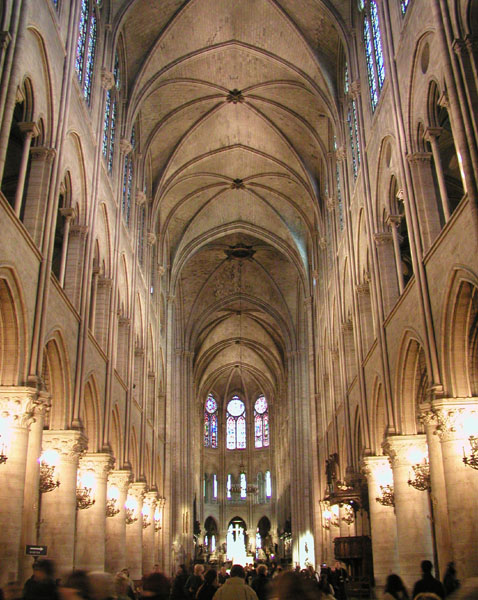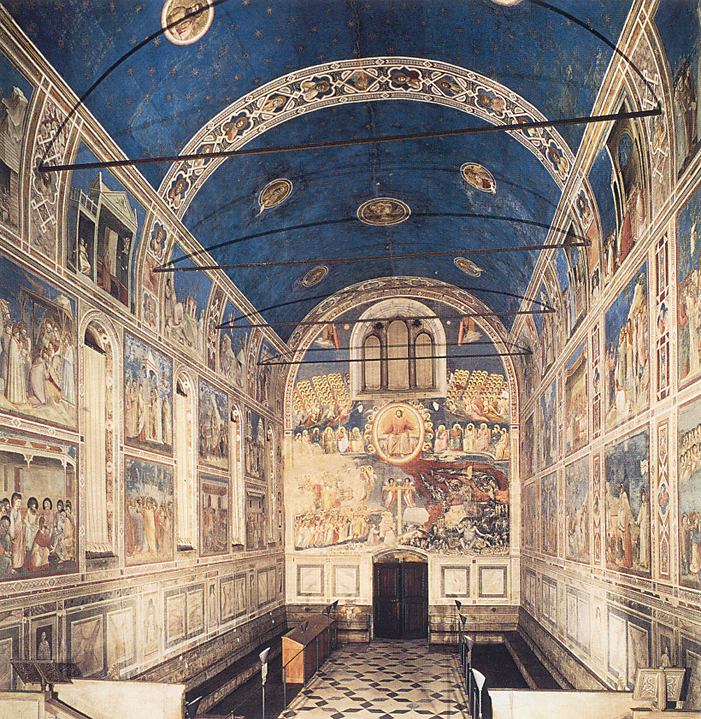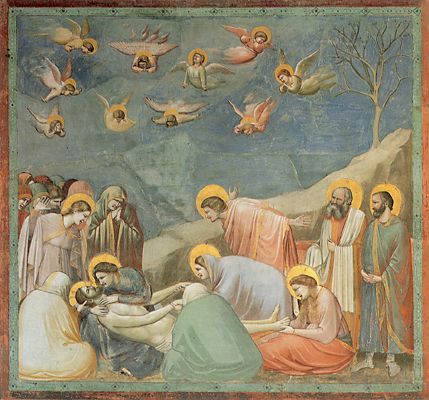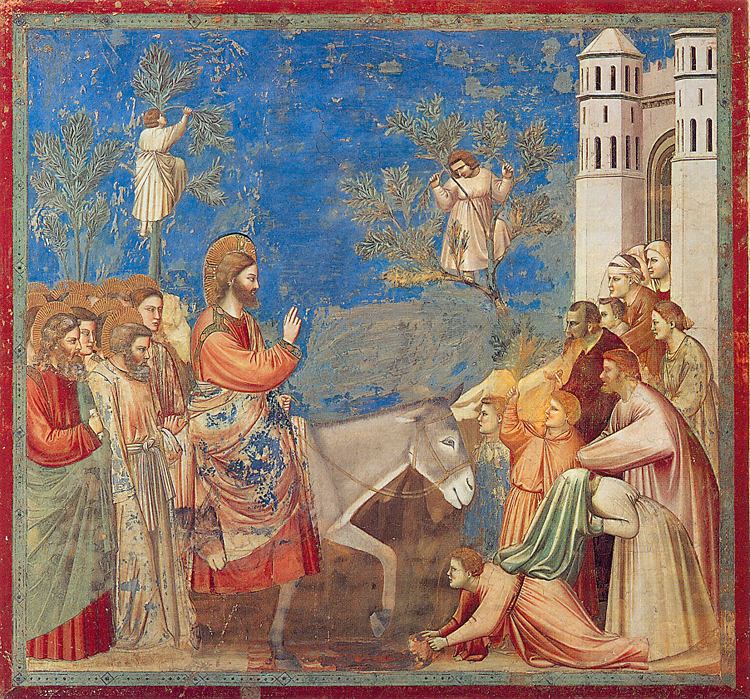

Posted on 10/08/2005 8:08:00 AM PDT by Republicanprofessor
In our last “class” on Greco-Roman, Early Christian and Byzantine Art, we saw how the realism of Greece and Rome was repudiated for more spiritual abstraction. The Christians saw the soul as more important than the weighty, physical body, and thus their works were flat and filled with the gold of paradise. My connection to spiritual twentieth century abstraction received mixed results, but that’s fine.
Today, we’ll see how artists gradually added some bulk and realism to their work from 1000-1400. Then in the next “class,” we’ll study how the Italian Renaissance united a rebirth of Greco-Roman realism with Christian subject matter.
The Dark Ages, from 600-800 A.D., saw little in the way of new forms of art. There were some beautiful portable objects fashioned by the roaming tribes of Vandals and Goths, but we’ll skip ahead. There were also some fine things made under Charlemagne around 800 A.D and under the Ottonians in Germany in the tenth century. We begin to get some monumental architecture at this time. Charlemagne’s Palace Chapel at Aachen revived much of the Byzantine glory from San Vitale in Ravenna, Italy; but Charlemagne’s architect, Odo of Merz, made the palace chapel at Aachen more solid and overtly powerful. They are both octagonal structures, but there is a much more complex spirituality, use of space and mosaics in the earlier San Vitale.


Charlemagne’s Palace Chapel at Aachen c. 800 and Justinian’s San Vitale 526-47
Hildesheim Cathedral is a wonderful work of Ottonian architecture. The stripes from here and from Aachen may derive from Islamic architecture (such as the Cordova mosque in Spain). You may also notice that t Hildesheim the walls are mostly bare; there are no columns to connect the arches below to the windows above. This will change as time goes on, and the walls will get busier and busier. What I also love about Hildesheim are the first monumental bronze doors since antiquity. This image of Adam and Eve being admonished by God is a classic case of passing the buck. The little figures are not very realistic, but the narrative is very clear, and that’s what they were striving for. I love it.

The mosque at Cordova.



Hildesheim Cathedral of St. Michael, bronze doors thereof
Now we jump into the Romanesque age proper. Medieval people believed that the world would end in 1000. When it didn’t, they began building massive churches in thanksgiving. These monumental buildings were not only used for church services, but they were also places of fortified protection in case of barbarian attacks. They were fireproof, acoustically wonderful and roomy enough for the added pilgrims. (One of the most “popular” events of the Middle Ages was making a pilgrimage to one of many sites, including Santiago de Compostela in Spain.)



Church of Ste. Foy, in Conques, France: exterior, west façade, nave view
Now we have to look at the architecture carefully and use difficult vocabulary words. This is even more difficult because I can’t be in the front of the class motioning to the buildings themselves. This architecture is called Romanesque because of its use of rounded Roman arches. This is continued into three dimensions in the barrel vault across the nave, the wider central aisle. Often there are two stories: the main story (called the nave arcade because of those arches alongside the nave,) and the second story called the gallery. At this time, the gallery allowed additional space for the pilgrims (and others) to gather upstairs for the service. They could also walk around the ambulatory, or aisle around the choir (or central, most sacred section of the church). Thus if mass was going on, others could walk around the mass and light their candles in the chapels off the apse (the rounded east end of the church) or the transept (that part that makes a cross of the church). These churches often had relics from one or more saints in the forms of reliquaries. I particularly like this reliquary of Ste. Foy (Saint Faith) at this same church.


Now, a constant concern of the Romanesque time was how to create lighting in these buildings. One cannot put a window into a barrel vault, just as one cannot remove a stone from an arch without it collapsing. One solution was to develop the groin vault, an intersection of two barrel vaults. The lovely church of Ste. Madeleine at Vezelay, France has such groin vaults and thus an upper clerestory of light (in addition to the lovely Medieval striping we’ve seen before). It is hard sometimes to see the edges of the groin vaults; they look a great deal like a barrel vault, but they aren’t. (If you look even more closely, you’ll see the Vezelay choir is Gothic in style. These churches were built over many decades, and as their styles often changed accordingly.)

It is also fun to study the decoration on these churches. There is not a great deal of Romanesque sculpture that is not connected to a church, and most of the painting of this time is tied to illuminated manuscripts. The rounded entrance to most of the churches (the tympanum) is often decorated with sculpture of the Last Judgment. Can you tell which side is Heaven and which is Hell? The elongated, skinny and non-realistic figures tell the story very well, especially the imaginative depictions of Satan and hell.

One wonderful work of Romanesque embroidery is the Bayeux Tapestry, commemorating the French Norman Conquest of England in 1066. It is over 200’ long and has wonderful, imaginative and lively figures gesturing, fighting and even cooking.

This is also the time of castles, and of troubadours singing of their lost ladies. One can even visit many of these castles as a tourist in Europe, either for the day or overnight. They are not much more expensive than a normal hotel room and have much more atmosphere (and sometimes an accompanying medieval dinner).

So how did Gothic architecture develop? Well, there was an orphan boy outside of Paris who was adopted by the church. In time, he became an abbot: Abbot Suger, who once presided over France when King Louis VII went off on the second crusade. Abbott Suger saw rich, beautiful visual objects as a way to approximate the glory of heaven. When his church of St. Denis was being rebuilt, the new choir contained pointed arches, rib vaults, and stained glass windows. The space here is less compartmentalized than that of the Romanesque churches. The consecration of this new spacious choir in 1144 is what begins the Gothic age.

Each Gothic cathedral is wonderful and unique; but it is too much to detail their full development here. Suffice it to say that Chartres rivaled Notre Dame in Paris. Pointed arches replaced round arches, allowing more height and the development of pointed vaults with ribs. They grew ever higher and higher, until reaching 144’ to the top of the rib vaults at Amiens Cathedral. They developed six-part and four-part rib vaults. Instead of the wide gallery on the second level, they developed a shallow level called the triforium, first seen at Chartres. Flying buttresses channeled the weight and energy from the ceiling out to the pier buttresses, so that the walls could open up to stained glass windows. The upper clerestory at Chartres is as high as the nave arcade, probably over 45’, since the cathedral reaches to 120’ to the top of the vaults. At the smaller chapel of La Sainte Chapelle, the walls are 75% glass. (The only buildings to surpass this structure of glass are the skyscrapers of the twentieth century.)


Notre Dame Paris with its matching towers and 6-part rib vaults


Chartres with its different towers, a higher clerestory and 4-part vaults;

Amiens with its 144’ vaults

La Ste-Chapelle with its 75% glass.
The Gothic was a time of new veneration for the Virgin Mary. The forgiveness of Christ took the place of the damning images from the Romanesque churches. Gothic sculpture became rounded and more realistic. In fact, as you walk right around Chartres Cathedral, you can see the development of sculpture from the 1194 west façade (or entrance) to the south portal (1205) and the north portal (1210). It’s really fun when you can recognize certain scenes: note Abraham and Isaac. I also love all the odd little sculpture under their feet, over their heads, etc. They had wonderful imaginations in the Middle Ages.



The great Gothic painter, from 1305, is actually called a proto-Renaissance artist because of the sense of weight and realism he ushered in. Giotto painted a series of frescos on the walls of the Arena Chapel in Padua that are wonderful in terms of color, composition and human content. His figures are well shaded (or modeled) and are no longer the flat, elongated figures of the Bayeaux Tapestry. For the first time since Roman times, he is actually looking at live models and drawing from them. His composition is simple and focused upon the simple gestures of Christ. For the first time, he uses the backs of figures and imbues them with emotion and character. His work is incredible and has inspired those as diverse as Masaccio, Michelangelo and Matisse (whose bright color and simplified compositions may be said to reflect some of Giotto’s work, however abstract they are in our eyes).

The Arena Chapel looking west toward the door.

The famous Lamentation.

The meeting of Mary’s parents at the Golden Gate when they know that they will bear her. Such a tender embrace is rare in art history.

My favorite is the Entry into Jerusalem, with the little figure on the right stuck in his cloak. He wanted to lay it down for Jesus, but he’s going to miss the whole event because he’s stuck. It is those human touches that move me the most.
Let me know what you like and why. This is probably one of the lectures that is least open to comment, but I hope that's not true. There are certainly no Mapplethorpe-type controversies. But I do hope you have questions and comments anyway.
Art Appreciation/Education ping.
Let me know if you want on or off this list.
ping me please?
Happy to. You're on the list.
See my home page if you want the links to the other series I've done.
please add me to your ping list
I failed the art quizzes provided by the FReeper Liz.
Thanks for sharing with us.
I didn't always do well on those quizzes myself; but I loved them. I got some grief when I tried that format myself to "test" the followers of my "classes."
I haven't heard from Liz, nor seen any of her posts, for a couple of months now. Any news of her? I worry sometimes.

Neither yours nor mine is Romanesque. But they are sexy.
I found this by accident, happily. Please put me on your list. I have been to some of the places you featured and am having a bout of nostalgia. I thoroughly enjoyed this lesson.
How I missed the first installment of this, I don't know. I know I'm on your list.
I teach art to adults one night a week and what I have used of your summer series, has livened up the students quite a bit.
The students don't paint like the artists in your summer series and feel free to critque the work, in the meantime, learning more about their own.
Thank you very much for your generosity. I've told class that the lessons are from a phantom professor, but being in Mass, I couldn't tell them your firt name is "Republican". LOL!
Yes, I did get a chuckle from that. But the less they know about my politics, the better. I'm glad the series started some debate. Do you show them the images on line, or print it out, or show your own slides? I'm always interested in technology.
The first one in this new series is: Art Appreciation/Education series II class #1: Greco-Roman Realism and Early Christian Abstraction http://www.freerepublic.com/focus/f-chat/1498966/posts.
It is "clickable" on my home page, but I can't quite deal with all that HTML here.
bump
My daughter made the pilgrimage to Santiago this summer. Unbelievable! I know it's supposed to be 12th century (at least the famous Gate of Glory) but it just looks different to me - almost Dutch in its elaboration.


Construction of the Cathedral started in 1075, when the town arrived to the climax of its importance. The chapel, Capilla del Salvador, is still conserved of this oldest epoch.
The second phase, after the wedding of Doña Urraca and Raimundo of Bourgogne, shows influences of french Romanesque style, as well as a style that is all Santiago's own, the so-called Románico Compostelano. The Obradoiro Facade (to which lateron were added Barroque elements) and the towers Torre de las Campanas and Torre
Through the Obradoiro Door you enter the so-called Old Cathedral, a Romanesque crypta with the first vaults of groined arches that were ever built in Spain.
The sculptures of the Portico de la Gloria, another entrance door, are considered some of the most important works of medieval art.
It has never played a large part in the medieval architecture courses I have taken and taught, perhaps because it is a mixture of styles. I'm also not a great fan of the busy Baroque style, so that's a second reason that I (probably unfairly) ignore it. I usually just use it to talk about the pilgrimage routes.
Did your daughter like her visit there?
Don't leave us hanging...tell us where you've been. My guess is Paris. I'm dying to go to Conques myself. I loved Vezelay; what a wonderful hill town (and great food, too. I can still taste those escargots!)
Thanks for the ping. Great class. (Has anyone seen Liz lately)
Aachen, Paris, Chartres. I do not eat escargot, even on New Years Eve. :)
Please add me to your list.
My favorite Gothic structure is the Dom Cathedral in Cologne Germany.
My favorite artist of the time is Albrecht Durer. The amount of detail in his works are incredible.
Aachen...tell me what that is like. I'm hoping to get there sometime.
We loved Chartres, but Reims even more. Chartres Cathedral was very dark. Reims had stained glass windows even over the doors and was awesome. (And we stayed in a wonderful place in Reims; what a splurge. I'll never forget it.)
Glad you get to travel...even if you don't like snails.
My favorite artist of the time is Albrecht Durer.
I have never been to Germany; there will be much to see when I get there.
Durer is really of the High Renaissance of the 16th century. His figures are well proportioned (influenced by the Italians), even if his women are a bit Teutonic. His detail is amazing.
For those who don't know Durer, here is his Adam and Eve and St. Jerome in his Study.


Disclaimer: Opinions posted on Free Republic are those of the individual posters and do not necessarily represent the opinion of Free Republic or its management. All materials posted herein are protected by copyright law and the exemption for fair use of copyrighted works.